
USS Impetuous (PYc-46) was a private yacht purchased by the Navy in August 1940 that served as a patrol boat of the United States Navy in Central America. The yacht was built as Paragon, the first of at least two Davol yachts to bear the name, in 1915 for Charles J. Davol of Providence, Rhode Island. In 1916 Davol sold the yacht to John Fred Betz, 3d of Philadelphia who renamed the yacht Sybilla III which served as the Section Patrol yacht USS Sybilla III (SP-104) from May 1917 to December 1918. Sybilla III remained in Betz's ownership until sale in 1935 to R. Livingston Sullivan of Philadelphia who renamed the yacht Arlis. On 12 August 1940 the Navy purchased the yacht placing it in commission as USS PC-454 on 16 October. The vessel was given the name Impetuous and reclassified PYc-46 on 15 July 1943. The yacht was decommissioned at Philadelphia 31 August 1944 and transferred to the War Shipping Administration for sale.
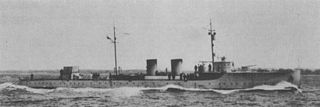
USS Winchester (SP-156) was an armed yacht that served in the United States Navy as a patrol vessel from 1917 to 1919. Prior to and following World War I, Winchester was a private yacht, later renamed Renard. In World War II, Renard was requisitioned for use in the Royal Canadian Navy as a patrol vessel, keeping her name. She was returned to her owners in 1944.

USS Isabel (SP-521), later PY-10, was a yacht in commission in the United States Navy as a destroyer from 1917 to 1920 and as a patrol yacht from 1921 to 1946.

USS Oceanographer (AGS-3) was a survey ship of the United States Navy during World War II that produced charts chiefly of passages in the Solomon Islands area of the Pacific Ocean. Upon transfer to the Navy, she had initially briefly been named and classed as gunboat USS Natchez (PG-85). Before her World War II Navy service, she had been USC&GS Oceanographer (OSS-26), a survey ship with the U.S. Coast and Geodetic Survey from 1930.

USS Sylph (PY-5) was a steel hulled steam yacht that served as a presidential yacht operating from the Washington Navy Yard from the late 19th century through the presidency of Woodrow Wilson. Afterwards the yacht was used by the Secretary of the Navy and Assistant Secretary of the Navy. After decommissioning and sale in 1929 the yacht was used as a party fishing boat in New York and later a ferry. Sometime around 1950 the line went out of business and the vessel was abandoned at a pier at West 37th Street, Sea Gate, Brooklyn. The pier and abandoned vessel were reduced by fire and storms to the waterline and wreckage in the sands which still may be exposed by storms.
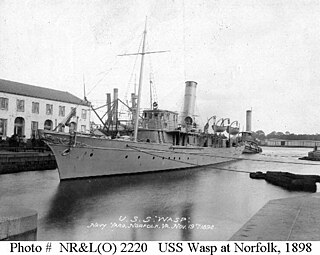
The seventh USS Wasp was the former yacht Columbia, purchased by the U.S. Navy and converted to an armed yacht serving from 1898 to 1919, with service in the Spanish–American War and World War I.

The first USS Vedette (SP-163) was a commercial yacht built in 1899. At the outbreak of World War I, the yacht was leased by the United States Navy, and was used as a section patrol craft in the North Atlantic Ocean. She served honorably during the war, rescuing survivors at sea, and attacking a German U-boat. At war’s end, she was converted to her original configuration and returned to her owner, the railroad executive, financier, and philanthropist Frederick W. Vanderbilt (1856-1938) of New York City.

USS Nokomis (SP-609) was a yacht purchased by the U.S. Navy during World War I. The yacht was purchased from Horace E. Dodge of Detroit, Michigan after he had the yacht luxuriously fitted out but before he could make use of his second Nokomis — the first having already gone into service.

Idealia was America's first diesel powered yacht built and owned by the Electric Launch Company (ELCO). The yacht was built in 1911, launched in 1912 and demonstrated the potential for use of diesel engines in yachts for several years thereafter. She yacht performed a public trial on the Hudson River on 22 October 1913 under the supervision of ELCO's manager Henry R. Sutphen with a gathering of naval architects and engineers as observers. Idealia was sold to individual owners after its period of demonstrating the diesel engine's pleasure craft utility.
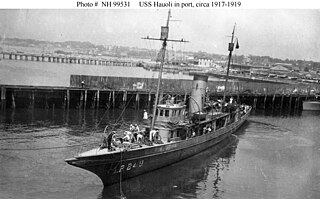
USS California (SP-249) was a yacht acquired by the United States Navy during World War I and outfitted as an armed section patrol vessel patrolling New York waterways. Later, renamed the original name of Hauoli, it was assigned to Thomas A. Edison conducting underwater listening experiments related to antisubmarine warfare.
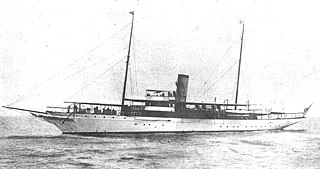
USS Lydonia (SP-700) was United States Navy patrol vessel in commission from 1917 to 1919 that saw service during World War I. Prior to her U.S. Navy service, she had been William A. Lydon's private yacht, Lydonia II, from 1912 to 1917. She spent most of the war based at Gibraltar, escorting and protecting Allied ships in the Mediterranean and along the Atlantic Ocean coast of Europe. After her U.S. Navy service ended, she served from 1919 to 1947 in the United States Coast and Geodetic Survey as the coastal survey ship USCGS Lydonia (CS-302).

USS Druid (SP-321) was a private yacht launched 10 February 1902 as Rheclair that was built for Daniel G. Reid. Reid sold the yacht to Senator Nelson W. Aldrich who renamed the yacht Nirvana only just over a year before his death. Aldrich's estate chartered Nirvana to John Wanamaker until it was bought by his son Rodman Wanamaker who used the yacht for cruising until a fire on 14 December 1916, just before a cruise south, severely damaged the vessel. He chartered an alternate vessel for his trip south and, after full repairs, the yacht was sold to Walter W. Dwyer who gave it the name Druid with intentions to sell the yacht to the government in order to finance a shipyard venture in Pensacola, Florida.

USS Zara (SP-133) was a steam yacht that was built in Scotland in 1890, passed through a number of British, Canadian and US owners, and ended up as a passenger steamship in Greece after the First World War. She was renamed several times, becoming Solgar, Electra and finally Zoodohos Pigi. In the latter part of the war she spent a year as an armed yacht in the United States Navy.

USS Coco (SP-110) was an armed motorboat that served in the United States Navy as a Section patrol vessel from 1917 to 1919.
USS Lady Anne (SP-154) was an armed motor launch that served in the United States Navy as a patrol vessel from 1917 to 1919.

The iron-hulled, single-screw steam yacht Utowana was completed in 1883 at Chester, Pennsylvania, by the Delaware River Iron Ship Building and Engine Works for Washington Everett Connor. On sale to Elias Cornelius Benedict the yacht's name was changed to Oneida (1887), then when Benedict bought a new yacht to be named Oneida and sale of the old yacht and conversion to a tow boat the name was changed to Adelante (1913). During Benedict's ownership Oneida was the covert site of an operation on President Grover Cleveland, a friend of Benedict's and frequent guest on the yacht, to remove a cancerous tumor in his mouth.

USS Kajeruna (SP-389) was a patrol vessel that served in the United States Navy from 1917 to 1919. The vessel had been built in 1902 as Hauoli for mining magnate Francis Marion "Borax" Smith but was replaced in 1903 by a second, larger vessel he named Hauoli. The first yacht was then named Seminole and for a time was returned to the builder, John N. Robins, and advertised for sale by the designer's firm. In 1911 Clinton W. Kinsella of New York purchased the yacht, apparently already renamed Kajeruna. After naval service the yacht was returned to the owner. On 31 March 1920 the ship was sold to British interests and renamed Tomas W. Beattie.
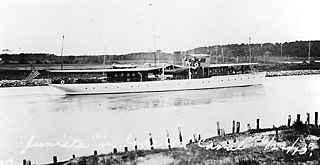
The second USS Juniata (SP-602) was a United States Navy patrol vessel in commission from 1 June 1917 to 13 July 1918. Juniata was built as the private gasoline-powered motor yacht Josephine for Edward Shearson of New York by Robert Jacobs at City Island in the Bronx, New York, in 1911. She was sold in 1914 to George W. Elkins of Philadelphia and renamed Juniata.

USS Marold (SP-737) was a United States Navy patrol vessel in commission from 1917 to 1919.

Rosinco was a diesel-powered luxury yacht that sank in Lake Michigan off the coast of Kenosha, Wisconsin in 1928. The yacht was built in 1916 as Georgiana III and served during World War I as USS Georgiana III, a Section patrol craft, under a free lease to the Navy by her owner and commanding officer. After the war the yacht was sold and renamed Whitemarsh in 1918. In 1925, after sale to Robert Hosmer Morse of Fairbanks-Morse, the yacht became Rosinco. She was sunk following a collision in 1928 and the wreck was added to the National Register of Historic Places in 2001.






















